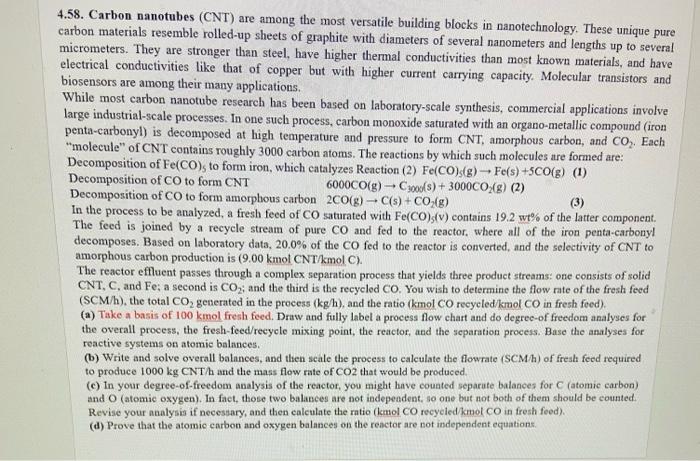4.58. Carbon nanotubes (CNT) are among the most versatile building blocks in nanotechnology. These unique pure carbon materials resemble rolled-up sheets of graphite with diameters of several nanometers and lengths up to several micrometers. They are stronger than steel, have higher thermal conductivities than most known materials, and have electrical conductivities like that of copper but with higher current carrying capacity. Molecular transistors and biosensors are among their many applications. While most carbon nanotube research has been based on laboratory-scale synthesis, commercial applications involve large industrial-scale processes. In one such process, carbon monoxide saturated with an organo-metallic compound (iron penta-carbonyl) is decomposed at high temperature and pressure to form CNT, amorphous carbon, and CO,. Each *molecule" of CNT contains roughly 3000 carbon atoms. The reactions by which such molecules are formed are: Decomposition of Fe(CO), to form iron, which catalyzes Reaction (2) Fe(CO):(8) - Fe(s) +5CO(8) (1) Decomposition of CO to form CNT 6000CO(g) - C3000) + 3000C028) (2) Decomposition of CO to form amorphous carbon 200(g) - C(s) + CO2(g) In the process to be analyzed, a fresh feed of CO saturated with Fe(CO),(v) contains 19.2 wt% of the latter component. The feed is joined by a recycle stream of pure Co and fed to the reactor, where all of the iron penta-carbonyl decomposes. Based on laboratory data, 20.0% of the co fed to the reactor is converted, and the selectivity of CNT to amorphous carbon production is (9.00 kmol CNT/kmol C). The reactor effluent passes through a complex separation process that yields three product streams: one consists of solid CNT, C, and Fe; a second is CO., and the third is the recycled Co. You wish to determine the flow rate of the fresh feed (SCM/h), the total CO2 generated in the process (kg/h), and the ratio (kmol CO recycled/kmol CO in fresh foed). (a) Take a basis of 100 kmol fresh feed. Draw and fully label a process flow chart and do degree of freedom analyses for the overall process, the fresh-feed/recycle mixing point, the reactor, and the separation process. Base the analyses for reactive systems on atomic balances (6) Write and solve overall balances, and then scale the process to calculate the flowrate (SCMh) of fresh feed required to produce 1000 kg CNT/h and the mass flow rate of CO2 that would be produced (e) in your degree-of-freedom analysis of the reactor, you might have counted separate balances for C (atomic carbon) and O (atomic oxygen). In fact, those two balances are not independent, so one but not both of them should be counted. Revise your analysis if necessary, and then calculate the ratio (Imol CO recycled/kmol CO in fresh food). (d) Prove that the atomic carbon and oxygen balances on the reactor are not independent equations







